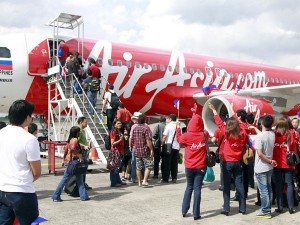AirAsia’s Indian venture plans take-off by yearend
MUMBAI, India—Asia’s biggest low-cost carrier AirAsia said Thursday its new airline joint venture with India’s giant tea-to-steel Tata conglomerate may start operations by yearend.
The new budget airline plans to operate from the southern Indian city of Chennai and boost connectivity between smaller towns for Indian travelers.
The time of the launch “is in the hands of the Indian regulator… but most likely it will start by the fourth quarter,” AirAsia’s chief executive Tony Fernandes said in a conference call to reporters.
AirAsia, headquartered in Kuala Lumpur, aims to invest between $30 million and $50 million in the venture, he said, and could hire up to 300 staff.
This is the first firm commitment of foreign investment in India’s aviation sector since the government last September relaxed rules to let overseas airlines take up to a 49 percent stake in domestic carriers.
Abu Dhabi-based Etihad Airways is in talks to pick up a stake in Jet Airways, India’s second-largest private airline by market share, but no decision has been announced.
AirAsia will hold 49 percent, Tata Sons—the group’s holding firm—30 percent and independent investor Telestar Tradeplace the balance in the venture, which was announced on Wednesday.
AirAsia—through its operations based in Thailand and Malaysia—already connects Southeast Asia with Chennai, other southern cities like Bangalore, Tiruchirappalli and Kochi and Kolkata in the east.
“It will have a fleet of A-320s. We plan to start with three to four planes and scale up quickly after that,” Fernandes said.
“AirAsia has proven credentials in the low-cost market. We expect them to start slowly in first few years and later expand,” said Kapil Kaul, CEO South Asia for aviation consultancy CAPA.
Low-cost carriers will completely dominate the country’s domestic and regional business, Kaul told AFP. The budget airlines currently hold a 60 percent share of India’s aviation market.
The airline sector was once vaunted as a symbol of the country’s economic vibrancy, with huge potential for growth. But its fortunes have nosedived due to over-expansion, intense competition, expensive fuel and low fares.
The AirAsia proposal—which awaits government and regulatory approval—would mark the Tata group’s return to aviation for the first time in around eight decades.
Former chairman J.R.D. Tata was passionate about planes and formed Tata Airlines in the 1930s. It was later nationalized by the government to become the country’s flagship Air India.
In the 1990s the Tatas floated a plan for a domestic carrier in India with Singapore Airlines, but the proposal fell through.
India’s Jet Airways, SpiceJet, GoAir and Air India are all worried about slowing passenger traffic and high costs.
Another carrier, debt-laden Kingfisher Airlines, which until recently was one of India’s leading operators, has been grounded since October and has lost its permit to fly.
Kingfisher, which is scouting desperately for funds in order to return to the skies, has never made a profit since it began flying in 2005 and owes vast sums to banks, airports, fuel suppliers and staff.
When asked if AirAsia’s entry could put some Indian airlines out of business, Fernandes said: “Businesses put themselves out of business. It is not competition which puts them out.”
